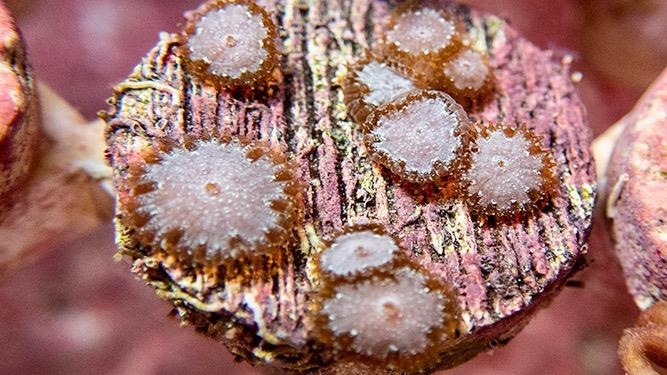According to a recent study carried out by experts at the University of Miami’s Rosenstiel School of Marine and Atmospheric Science, baby corals are equally as susceptible to a lethal disease that has been spreading throughout Florida’s reefs since 2014.
 Healthy, eight-month-old baby brain corals being raised in the Coral Reef Futures lab at the Rosenstiel School. Image Credit: Liv Williamson, Ph.D
Healthy, eight-month-old baby brain corals being raised in the Coral Reef Futures lab at the Rosenstiel School. Image Credit: Liv Williamson, Ph.D
The findings revealed that Stony Coral Tissue Loss Disease (SCTLD) affects baby corals in the same way as it affects adult colonies, with identical severity and mortality. This is the first study to illustrate how coral sickness affects baby corals.
Since baby corals have not been included in surveys of the disease on Florida’s reefs, we have likely underestimated the extent of mortality caused by this disease. That’s like trying to understand how COVID-19 spreads through a population by examining only adults, without looking at whether and how the disease affects children.
Olivia Williamson, PhD Candidate, Department of Marine Biology and Ecology, UM Rosenstiel School
The researchers subjected lab-raised juveniles of two brain coral species, four-month-old boulder brain coral (Colpophyllia natans) and eight-month-old grooved brain coral (Diploria labyrinthiformis), to water-containing colonies with active SCTLD for four weeks to perform the study. Within 48 hours of exposure, both species developed lesions.
Approximately 60% of the boulder brain coral babies lost all tissue and perished within two to eight days after developing lesions during the initial exposure. At the same time, just one of the disease-exposed grooved brain coral infants died, whereas 38% of the disease-exposed grooved brain coral babies had active disease lesions.
They also discovered that larger babies, as well as babies that were clustered together in groups, were less likely to develop the disease and die than the smaller, more isolated babies.
Williamson added, “There is a ray of hope in that size matters, and there is safety in numbers. Since some of them avoided becoming infected at all, it suggests that some corals harbor a degree of resistance—or are at least, relatively less susceptible to disease.”
The researchers gave the surviving coral babies a second dose to test their resilience after 20 days, and all of them died within six days.
The findings serve as a timely reminder to coral restoration specialists about the potential of SCTLD in the baby corals they develop and outplant, but they also suggest that this risk may be mitigated by growing coral recruits bigger and encouraging grouping before outplanting.
Due to insufficient data on coral recruitment, juvenile corals are equally or more sensitive to SCTLD than adult colonies, implying that the magnitude of mortality caused by SCTLD on reefs was underestimated.
The study team intends to perform more laboratory trials to discover sources of resistance and to assist in the breeding and raising of baby corals that are resistant to the disease.
Since initially arriving in the waters around Miami in 2014, stony coral tissue loss disease has expanded over all of Florida’s coral reefs and the wider Caribbean, destroying millions of coral colonies and impacting over 20 different coral species. The disease, which affects reef-building corals and creates white lesions and fast tissue loss, is yet to be recognized.
The study was published in the journal Frontiers in Marine Science in May 2022. Olivia Williamson, Carly Dennison, Andrew Baker of the UM Rosenstiel School, and Keri O'Neil of the Florida Aquarium are among the study’s authors.
The study was funded by a fellowship from the UM Cooperative Institute of Marine and Atmospheric Studies (CIMAS), as well as funding from the Florida Department of Environmental Protection and the National Oceanic and Atmospheric Administration’s (NOAA) Coral Reef Conservation Program.
Journal Reference:
Williamson, M. O, et al., (2022) Susceptibility of Caribbean Brain Coral Recruits to Stony Coral Tissue Loss Disease (SCTLD). Frontiers in Marine Science. doi.org/10.3389/fmars.2022.821165.